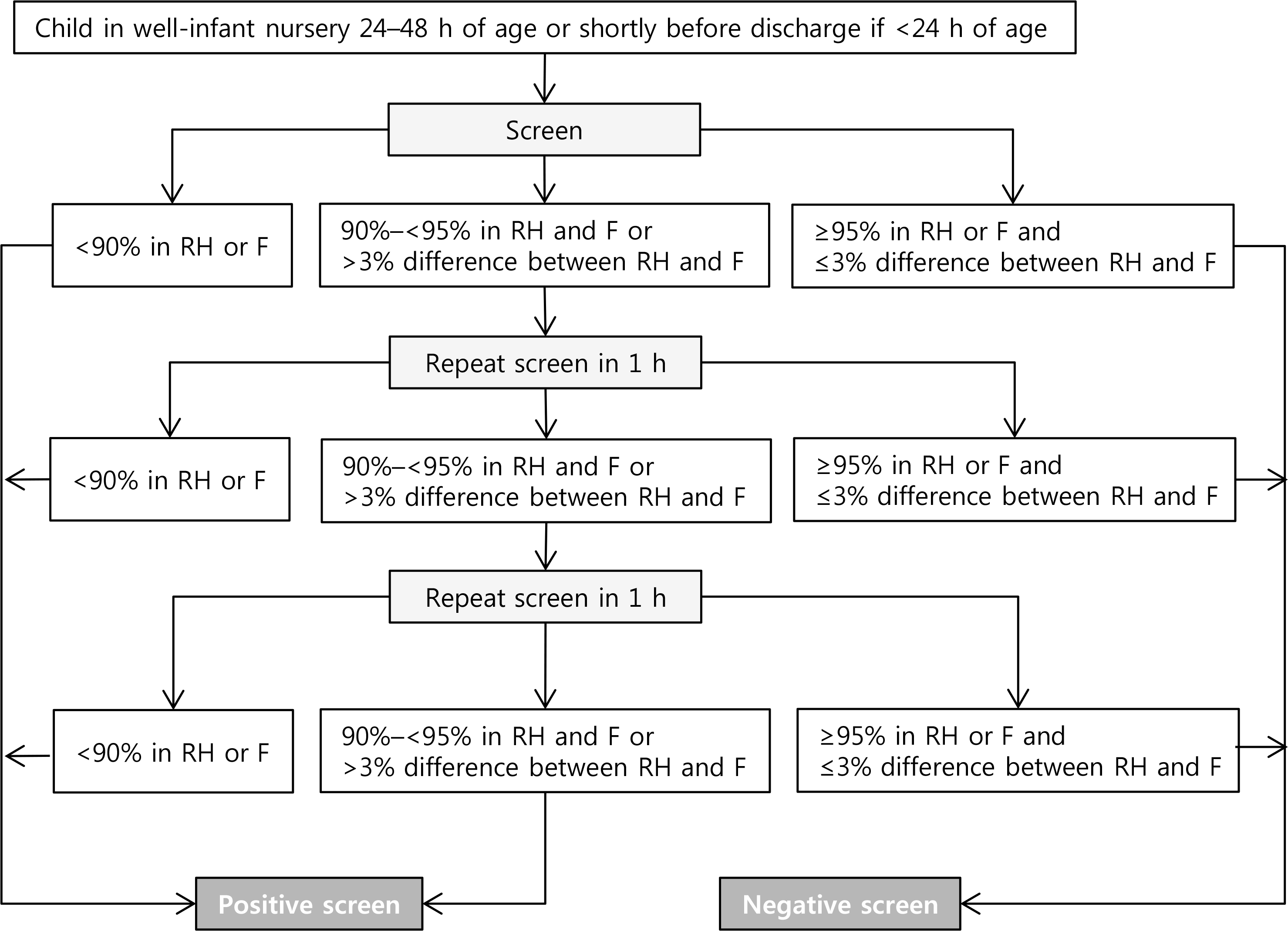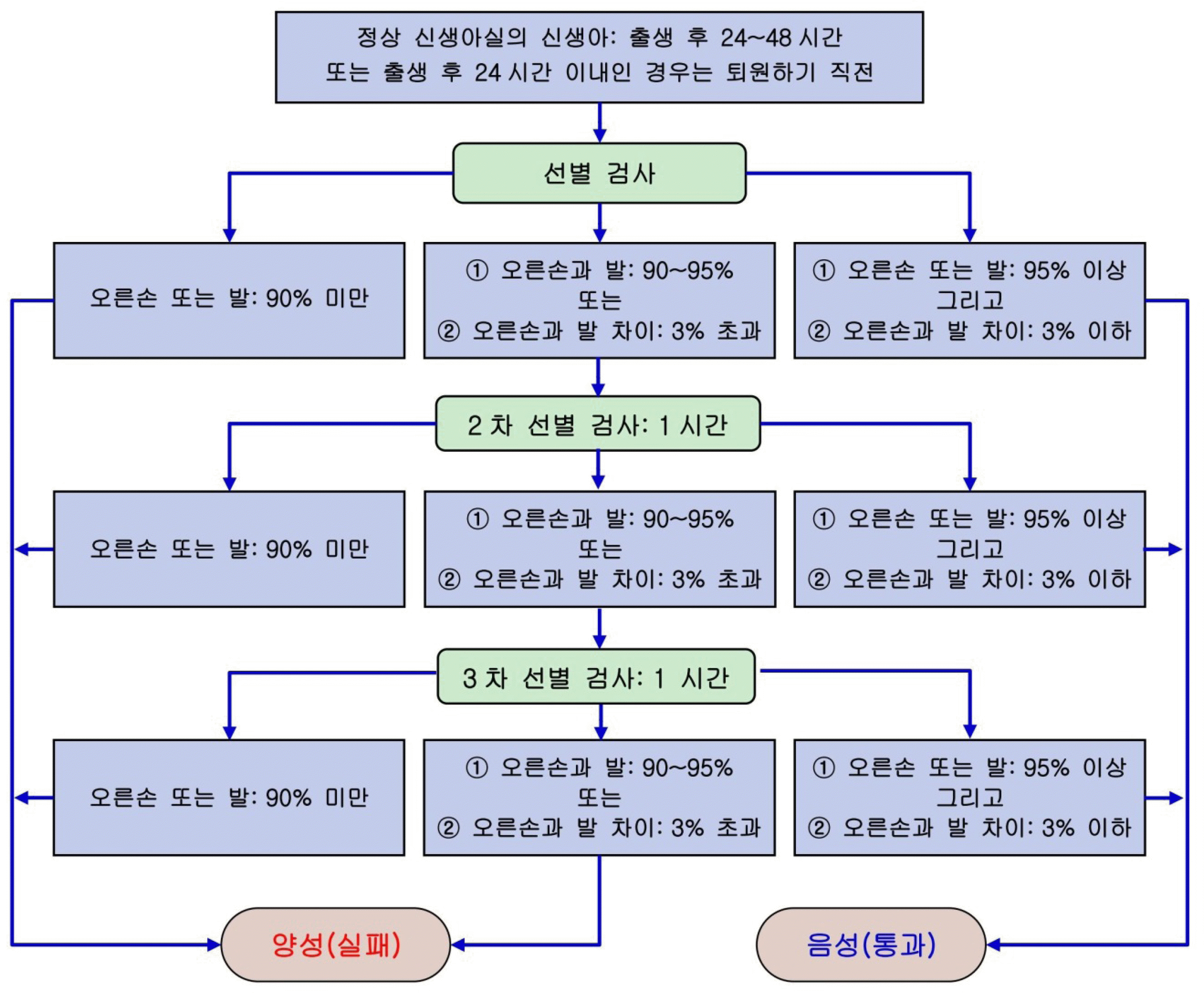Abstract
Critical congenital heart defects can lead to serious morbidity and mortality if not found at the appropriate time. Although prenatal ultrasound and postnatal neonatal physical examination can detect the majority of severe congenital heart disease, more than 20% of newborns are still not diagnosed before discharge from the birth hospital. The diagnosis of critical congenital heart defects using pulse oximetry can reduce these diagnostic problems, and it is necessary to consider introducing it as a neonatal screening test in Korea. However, as the prevalence rate of disease and the medical system vary from country to country, it is necessary to study whether this screening test is effective or cost effective in our country. Newborns with a positive result that did not pass a critical congenital heart defects screening using pulse oximetry would require thorough follow-up testing to identify not only severe congenital heart disease but also other potential causes of hypoxia. However, even if the neonate has passed the critical congenital heart defects screening test using pulse oximetry, this screening test has a low sensitivity and a high false positive rate, so it cannot be a perfect screening test for critical congenital heart defects. Therefore, when this screening test is performed at each hospital, it is important to educate and follow the caregivers of signs and symptoms of other congenital heart diseases other than hypoxemia.
REFERENCES
1). Heron MP., Smith BL. Deaths: leading causes for 2003. Natl Vital Stat Rep. 2007. 55:1–92.
2). Rosano A., Botto LD., Botting B., Mastroiacovo P. Infant mortality and congenital anomalies from 1950 to 1994: an international perspective. J Epidemiol Community Health. 2000. 54:660–6.

3). Chung SH., Choi YS., Bae CW. Changes in the neonatal and infant mortality rate and the causes of death in Korea. Korean J Pediatr. 2011. 54:443–55.

4). Brown KL., Sullivan ID. Prenatal detection for major congenital heart disease: a key process measure for congenital heart networks. Heart. 2014. 100:359–60.

5). Eckersley L., Sadler L., Parry E., Finucane K., Gentles TL. Timing of diagnosis affects mortality in critical congenital heart disease. Arch Dis Child. 2016. 101:516–20.

6). Hoke TR., Donohue PK., Bawa PK., Mitchell RD., Pathak A., Rowe PC, et al. Oxygen saturation as a screening test for critical congenital heart disease: a preliminary study. Pediatr Cardiol. 2002. 23:403–9.

7). Manzoni P., Martin GR., Luna MS., Mestrovic J., Simeoni U., Zimmermann L, et al. Pulse oximetry screening for critical congenital heart defects: a European consensus statement. Lancet Child Adolesc Health. 2017. 1:88–90.

8). Botto LD., Correa A., Erickson JD. Racial and temporal variations in the prevalence of heart defects. Pediatrics. 2001. 107:E32.

9). Korean Statisical Information Service. Infant death and mortality. [accessed on 17 May, 2017]. Available at. http://kosis.kr/eng/statisticsList/statisticsList_01List.jsp?vwcd=MT_ETITLE&parentId=D#SubCont.
10). Liske MR., Greeley CS., Law DJ., Reich JD., Morrow WR., Baldwin HS, et al. Report of the tennessee task force on screening newborn infants for critical congenital heart disease. Pediatrics. 2006. 118:e1250–6.

11). Reller MD., Strickland MJ., Riehle-Colarusso T., Mahle WT., Correa A. Prevalence of congenital heart defects in metropolitan Atlanta, 1998-2005. J Pediatr. 2008. 153:807–13.

12). Jung JW. Nationwide Survey on the Incidence and Type of Congenital Heart Disease. DaeJeon: Korea Center for Disease Control & Prevention;2009.
13). Choi JS., Seo K., Han YJ., Lee SW., Bu YK., Lee SW, et al. Congenital anomaly survey and stasistics. Sejong: Korea Institute for Health and Social Affairs;2009. Report No.:. p. 2009–62.
14). Brown KL., Ridout DA., Hoskote A., Verhulst L., Ricci M., Bull C. Delayed diagnosis of congenital heart disease worsens preoperative condition and outcome of surgery in neonates. Heart. 2006. 92:1298–302.

15). Bonnet D., Coltri A., Butera G., Fermont L., Le Bidois J., Kachaner J, et al. Detection of transposition of the great arteries in fetuses reduces neonatal morbidity and mortality. Circulation. 1999. 99:916–8.

16). Franklin O., Burch M., Manning N., Sleeman K., Gould S., Archer N. Prenatal diagnosis of coarctation of the aorta improves survival and reduces morbidity. Heart. 2002. 87:67–9.

17). Tworetzky W., McElhinney DB., Reddy VM., Brook MM., Hanley FL., Silverman NH. Improved surgical outcome after fetal diagnosis of hypoplastic left heart syndrome. Circulation. 2001. 103:1269–73.

18). Peterson C., Dawson A., Grosse SD., Riehle-Colarusso T., Olney RS., Tanner JP, et al. Hospitalizations, costs, and mortality among infants with critical congenital heart disease: how important is timely detection? Birth Defects Res A Clin Mol Teratol. 2013. 97:664–72.

19). Gaynor JW., Stopp C., Wypij D., Andropoulos DB., Atallah J., Atz AM, et al. Neurodevelopmental outcomes after cardiac surgery in infancy. Pediatrics. 2015. 135:816–25.

20). Goldberg CS., Lu M., Sleeper LA., Mahle WT., Gaynor JW., Williams IA, et al. Factors associated with neurodevelopment for children with single ventricle lesions. J Pediatr. 2014. 165:490–6. .e8.

21). Bahtiyar MO., Copel JA. Improving detection of fetal cardiac anomalies: a fetal echocardiogram for every fetus? J Ultrasound Med. 2007. 26:1639–41.
22). Griebsch I., Knowles RL., Brown J., Bull C., Wren C., Dezateux CA. Comparing the clinical and economic effects of clinical examination, pulse oximetry, and echocardiography in newborn screening for congenital heart defects: a probabilistic cost-effectiveness model and value of information analysis. Int J Technol Assess Health Care. 2007. 23:192–204.

23). Oster ME., Lee KA., Honein MA., Riehle-Colarusso T., Shin M., Correa A. Temporal trends in survival among infants with critical congenital heart defects. Pediatrics. 2013. 131:e1502–8.

24). Dawson AL., Cassell CH., Riehle-Colarusso T., Grosse SD., Tanner JP., Kirby RS, et al. Factors associated with late detection of critical congenital heart disease in newborns. Pediatrics. 2013. 132:e604–11.

25). Kemper AR., Mahle WT., Martin GR., Cooley WC., Kumar P., Morrow WR, et al. Strategies for implementing screening for critical congenital heart disease. Pediatrics. 2011. 128:e1259–67.

26). NewSTEPS. Newborn Screening Status for All Disorders. [accessed on 30 August, 2017]. Available at. https://www.newsteps.org/newborn-screening-status-all-disorders.
27). de-Wahl Granelli A., Wennergren M., Sandberg K., Mellander M., Bejlum C., Inganäs L, et al. Impact of pulse oximetry screening on the detection of duct dependent congenital heart disease: a Swedish prospective screening study in 39,821 newborns. BMJ. 2009. 338:a3037.
28). Ewer AK., Martin GR. Newborn pulse oximetry screening: which algorithm is best? Pediatrics. 2016. 138:e20161206.

29). Ewer AK., Granelli AD., Manzoni P., Sánchez Luna M., Martin GR. Pulse oximetry screening for congenital heart defects. Lancet. 2013. 382:856–7.

30). Thangaratinam S., Brown K., Zamora J., Khan KS., Ewer AK. Pulse oximetry screening for critical congenital heart defects in asymptomatic newborn babies: a systematic review and meta-analysis. Lancet. 2012. 379:2459–64.

31). Mahle WT., Newburger JW., Matherne GP., Smith FC., Hoke TR., Koppel R, et al. Role of pulse oximetry in examining newborns for congenital heart disease: a scientific statement from the AHA and AAP. Pediatrics. 2009. 124:823–36.
32). Riede FT., Wörner C., Dähnert I., Möckel A., Kostelka M., Schneider P. Effectiveness of neonatal pulse oximetry screening for detection of critical congenital heart disease in daily clinical routine—results from a prospective multicenter study. Eur J Pediatr. 2010. 169:975–81.

33). Meberg A., Brügmann-Pieper S., Due R Jr., Eskedal L., Fagerli I., Farstad T, et al. First day of life pulse oximetry screening to detect congenital heart defects. J Pediatr. 2008. 152:761–5.

34). Ewer AK., Middleton LJ., Furmston AT., Bhoyar A., Daniels JP., Thangara-tinam S, et al. Pulse oximetry screening for congenital heart defects in newborn infants (PulseOx): a test accuracy study. Lancet. 2011. 378:785–94.

35). Schena F., Picciolli I., Agosti M., Zuppa AA., Zuccotti G., Parola L, et al. perfusion index and pulse oximetry screening for congenital heart defects. J Pediatr. 2017. 183:74–9. .e1.

36). Martin GR., Beekman RH 3rd., Mikula EB., Fasules J., Garg LF., Kemper AR, et al. Implementing recommended screening for critical congenital heart disease. Pediatrics. 2013. 132:e185–92.

37). Singh A., Rasiah SV., Ewer AK. The impact of routine predischarge pulse oximetry screening in a regional neonatal unit. Arch Dis Child Fetal Neonatal Ed. 2014. 99:F297–302.

38). Oster ME., Colarusso T., Glidewell J. Screening for critical congenital heart disease: a matter of sensitivity. Pediatr Cardiol. 2013. 34:203–4.

39). Ailes EC., Gilboa SM., Honein MA., Oster ME. Estimated number of infants detected and missed by critical congenital heart defect screening. Pediatrics. 2015. 135:1000–8.

40). Manja V., Mathew B., Carrion V., Lakshminrusimha S. Critical congenital heart disease screening by pulse oximetry in a neonatal intensive care unit. J Perinatol. 2015. 35:67–71.

41). Fernandes N., Short B., Manja V., Lakshminrusimha S. Critical congenital heart disease screening in NICU: need for revision and standardization. Am J Perinatol. 2017. 34:1470–6.
42). Oster ME., Aucott SW., Glidewell J., Hackell J., Kochilas L., Martin GR, et al. Lessons learned from newborn screening for critical congenital heart defects. Pediatrics. 2016. 137:e20154573.

43). Van Naarden Braun K., Grazel R., Koppel R., Lakshminrusimha S., Lohr J., Kumar P, et al. Evaluation of critical congenital heart defects screening using pulse oximetry in the neonatal intensive care unit. J Perinatol. 2017. 37:1117–23.

44). Kochilas LK., Lohr JL., Bruhn E., Borman-Shoap E., Gams BL., Pylipow M, et al. Implementation of critical congenital heart disease screening in Minnesota. Pediatrics. 2013. 132:e587–94.

Fig. 1
Algorithm of pulse oximetry screening for critical congenital heart defects.25 RH, right hand; F, Foot.

Table 1.
Common Critical Congenital Heart Defects and AssociatedClinical Characteristics
| Lesions | Prevalence∗ | Hypoxemia | Ductal Dependency |
|---|---|---|---|
| Left-sided obstructive lesions | |||
| Hypoplastic left heart syndrome | 0.34 | All | All |
| Aortic valve atresia/stenosis | 0.48 | Uncommon | Some |
| Coarction of aorta | 2.62 | Some | Some |
| Interrupted aortic arch | Somel | All | |
| Right-sided obstructive lesions | |||
| Tetralogy of fallot | 4.55 | Most | most |
| Pulmonary atresia/stenosis | 4.85 | All | All |
| Tricuspid atresia | 0.41 | All | Some |
| Ebstein anomaly | 0.23 | Some | Some |
| Parallel circulation | |||
| Transposition of great arteries | 1.68 | Some | Uncommon |
| Others | |||
| Total anomalous pulmonary | 0.80 | All | None |
| Truncus arteriosus | 0.16 | None | None |
| Double-outlet right ventricle | 2.16 | Some | Some |
| Single ventricle | 0.41 | Some | Some |




 PDF
PDF ePub
ePub Citation
Citation Print
Print



 XML Download
XML Download